Credit Screening Dataset
Previous page
Continued from
Classic Jupyter notebook
Train Test Split the dataset
We will spot-check various algorithms using train test validation as well as kfold cross validation.
We shall first split the entire data as Train and test.
X, y = df2.drop(targetAttr, axis = 1), df2['A16']
# Train test split
X_train, X_test, y_train, y_test = train_test_split(X, y, random_state=42, stratify = y)
print("X_train shape : {}".format(X_train.shape))
print("X_test shape : {}".format(X_test.shape))
print("y_train shape : {}".format(y_train.shape))
print("y_test shape : {}".format(y_test.shape))
X_train shape : (489, 15)
X_test shape : (164, 15)
y_train shape : (489,)
y_test shape : (164,)
X_train.head()
| A1 | A2 | A3 | A4 | A5 | A6 | A7 | A8 | A9 | A10 | A11 | A12 | A13 | A14 | A15 | |
|---|---|---|---|---|---|---|---|---|---|---|---|---|---|---|---|
| 7 | a | 22.92 | 11.585 | u | g | cc | v | 0.040 | t | f | 0.0 | f | g | 80.0 | 1349.0 |
| 64 | b | 26.67 | 4.250 | u | g | cc | v | 4.290 | t | t | 1.0 | t | g | 120.0 | 0.0 |
| 320 | b | 21.25 | 1.500 | u | g | w | v | 1.500 | f | f | 0.0 | f | g | 150.0 | 8.0 |
| 358 | b | 32.42 | 3.000 | u | g | d | v | 0.165 | f | f | 0.0 | t | g | 120.0 | 0.0 |
| 628 | b | 29.25 | 13.000 | u | g | d | h | 0.500 | f | f | 0.0 | f | g | 228.0 | 0.0 |
Transformation Pipelines
We will create list of pipelines for Simple hold out validation. This list of pipelines will contain composite estimators/classifiers.
We will be iterating through the individual pipelines within the pipeline list specifically for simple holdout validation. In each iteration :
- the results on train and test set will be displayed in the form of classification report.
- the confusion matrix for prediction on test data will be displayed.
- The measures ‘Accuracy’, ‘F1 score’, ‘precision’ and ‘recall’ will be extracted and stored in a dictionary. Note that the average parameter chosen is ‘weighted’ for the three measures - accuracy, precision and recall.
- A confusion matrix for performance of the model on test set will be displayed.
- An ROC curve with AUC scores will be plotted that will aid us in assessing the model’s capability in distinguishing between classes.
Once an entire loop of training and testing of each model within the pipeline list is completed, the dictionary will be converted into a dataframe and a plot shall be drawn to compare the results from the different classifier models.
# Creating numeric Pipeline for standard scaling of numeric features
from sklearn.pipeline import Pipeline
from sklearn.preprocessing import StandardScaler
num_pipeline = Pipeline([
('std_scaler', StandardScaler())])
df2_num_tr = num_pipeline.fit_transform(df2[contAttr])
pd.DataFrame(df2_num_tr)
| 0 | 1 | 2 | 3 | 4 | 5 | |
|---|---|---|---|---|---|---|
| 0 | -0.0570 | -0.9614 | -0.2952 | -0.3026 | 0.1287 | -0.1931 |
| 1 | 2.2965 | -0.0736 | 0.2362 | 0.7045 | -0.8168 | -0.0864 |
| 2 | -0.5921 | -0.8619 | -0.2210 | -0.5040 | 0.5925 | -0.0362 |
| 3 | -0.3106 | -0.6549 | 0.4470 | 0.5031 | -0.4779 | -0.1926 |
| 4 | -0.9581 | 0.1584 | -0.1586 | -0.5040 | -0.3589 | -0.1931 |
| ... | ... | ... | ... | ... | ... | ... |
| 648 | -0.8812 | 1.0462 | -0.2952 | -0.5040 | 0.4736 | -0.1931 |
| 649 | -0.7468 | -0.8121 | -0.0725 | -0.1012 | 0.1168 | -0.1181 |
| 650 | -0.5287 | 1.7261 | -0.0725 | -0.3026 | 0.1168 | -0.1929 |
| 651 | -1.1483 | -0.9206 | -0.6544 | -0.5040 | 0.5925 | -0.0502 |
| 652 | 0.2956 | -0.2896 | 1.7948 | -0.5040 | -1.0725 | -0.1931 |
653 rows × 6 columns
Transforming the X_train and X_test
from sklearn.compose import ColumnTransformer
from sklearn.preprocessing import OneHotEncoder
# Segregating the numeric and categorical features
num_attribs = ['A2', 'A3','A8', 'A11', 'A14', 'A15']
cat_attribs = ["A1","A4", "A5", "A6", "A7", "A9", "A10", "A12", "A13"]
# Creating Column Transformer for selectively applying tranformations
# both standard scaling and one hot encoding
full_pipeline = ColumnTransformer([
("num", num_pipeline, num_attribs),
("cat", OneHotEncoder(handle_unknown='ignore'), cat_attribs)])
# Creating Column Transformer for selectively applying tranformations
# only one hot encoding and no standard scaling
categorical_pipeline = ColumnTransformer([
("num_selector", "passthrough", num_attribs),
("cat", OneHotEncoder(handle_unknown='ignore'), cat_attribs)])
# Learning the parameters for transforming from train set using full_pipeline
# Transforming both train and test set
X_train_tr1 = full_pipeline.fit_transform(X_train)
X_test_tr1 = full_pipeline.transform(X_test)
# Learning the parameters for transforming from train set using categorical pipeline
# Transforming both train and test set
X_train_tr2 = categorical_pipeline.fit_transform(X_train)
X_test_tr2 = categorical_pipeline.transform(X_test)
Transforming the target variable
from sklearn.preprocessing import LabelEncoder
# prepare input data
def prepare_targets(y_train, y_test):
le = LabelEncoder()
le.fit(np.ravel(y_train))
y_train_enc = le.transform(np.ravel(y_train))
y_test_enc = le.transform(np.ravel(y_test))
return y_train_enc, y_test_enc
y_train_tr, y_test_tr = prepare_targets(y_train, y_test)
Training and Testing Models
As discussed in the transformation pipelines section, an entire loop of training and testing of each model within the pipeline list will be done. The scores from each iteration will be extracted and stored in a dictionary. After complete run, the dictionary will be converted into a dataframe and comparison plot drawn to evaluate the different classifier models.
# Function for returning a string containing
# Classification report and the accuracy, precision, recall and F1 measures on train and test data
# The average parameter for the measures is 'weighted' as the dataset is balanced.
from sklearn.metrics import recall_score, precision_score, accuracy_score, \
confusion_matrix, ConfusionMatrixDisplay, classification_report, f1_score, \
roc_curve, auc
def evaluation_parametrics(y_train,yp_train,y_test,yp_test,average_param = 'weighted'):
'''
average_param : values can be 'weighted', 'micro', 'macro'.
Check link:
https://scikit-learn.org/stable/modules/model_evaluation.html#scoring-parameter
https://scikit-learn.org/stable/modules/classes.html#module-sklearn.metrics
https://scikit-learn.org/stable/modules/generated/sklearn.metrics.precision_score.html#sklearn.metrics.precision_score
'''
d = 2
txt = "-"*60 \
+ "\nClassification Report for Train Data\n" \
+ classification_report(y_train, yp_train) \
+ "\nClassification Report for Test Data\n" \
+ classification_report(y_test, yp_test) \
+ "\n" + "-"*60 + "\n" \
+ "Accuracy on Train Data is: {}".format(round(accuracy_score(y_train,yp_train),d)) \
+ '\n' \
+ "Accuracy on Test Data is: {}".format(round(accuracy_score(y_test,yp_test),d)) \
+ "\n" + "-"*60 + "\n" \
+ "Precision on Train Data is: {}".format(round(precision_score(y_train,yp_train,average = average_param),d)) \
+ "\n" \
+ "Precision on Test Data is: {}".format(round(precision_score(y_test,yp_test,average = average_param),d)) \
+ "\n" + "-"*60 + "\n" \
+ "Recall on Train Data is: {}".format(round(recall_score(y_train,yp_train,average = average_param),d)) \
+ "\n" \
+ 'Recall on Test Data is: {}'.format(round(recall_score(y_test,yp_test,average = average_param),d)) \
+ "\n" + "-"*60 + "\n" \
+ "F1 Score on Train Data is: {}".format(round(f1_score(y_train,yp_train,average = average_param),d)) \
+ "\n" \
+ "F1 Score on Test Data is: {}".format(round(f1_score(y_test,yp_test,average = average_param),d)) \
+ "\n" + "-"*60 + "\n"
return txt
def Confusion_matrix_ROC_AUC(name, alias, pipeline,
X_train_tr, y_train_tr,
X_test_tr,y_test_tr):
'''
This function reurns three plots :
- Confusion matrix on testset predictions
- Classification report for performance on train and test set
- roc and auc curve for test set predictions
The arguments are :
name : short/terse name for the composite estimator
alias : descriptive name for the composite estimator
pipeline : Composite estimator
X_train_tr, y_train_tr : train set feature matrix, train set target
X_test_tr,y_test_tr : test set feature matrix, test set target
For reference, below is a list containing the tuple of (name, alias, pipeline)
[('SGD', 'Stochastic Gradient Classifier',SGDClassifier(random_state=42)),
('LR','Logistic Regression Classifier', LogisticRegression(max_iter = 1000,random_state = 48)),
('RF','Random Forest Classifier', RandomForestClassifier(max_depth=2, random_state=42)),
('KNN','KNN Classifier',KNeighborsClassifier(n_neighbors = 7)),
('NB','Naive Bayes Classifier', GaussianNB()),
('SVC','Support Vector Classifier',
`LinearSVC(class_weight='balanced', verbose=False, max_iter=10000, tol=1e-4, C=0.1)),
('CART', 'CART', DecisionTreeClassifier(max_depth = 7,random_state = 48)),
('GBM','Gradient Boosting Classifier',
GradientBoostingClassifier(n_estimators=50, max_depth=10)),
('LDA', 'LDA Classifier', LinearDiscriminantAnalysis())]
For instance, if the classifier is an SGDClassifier, the suggested name and alias are :
'SGD'/'sgdclf', 'Stochastic Gradient Classifier'.
It is recommended to adhere to name and alias conventions,
- as the name argument is used to for checking whether calibrated Classifier CV is required or not.
- as the alias argument will be used as title in the Classification report plot.
Call the functions : evaluation_parametrics
Check the links :
https://peps.python.org/pep-0008/#maximum-line-length
https://scikit-learn.org/stable/glossary.html#term-predict_proba
Example :
>> Confusion_matrix_ROC_AUC('sgd_clf','Stochastic Gradient Classifier',sgd_clf,
X_train_tr, y_train_tr, X_test_tr,y_test_tr)
'''
from sklearn.metrics import recall_score, precision_score, accuracy_score, \
confusion_matrix, ConfusionMatrixDisplay, classification_report, f1_score, \
roc_curve, auc
from sklearn.calibration import CalibratedClassifierCV
fig = plt.figure(figsize=(10,5), dpi = 130)
gridsize = (2, 3)
ax1 = plt.subplot2grid(gridsize, (0, 0), colspan=1, rowspan=1)
ax2 = plt.subplot2grid(gridsize, (0, 1), colspan = 2, rowspan = 2)
ax3 = plt.subplot2grid(gridsize, (1, 0), colspan = 1)
sns.set(font_scale=0.75) # Adjust to fit
#---------------------------------------------------------------------------------
# Displaying the confusion Matrix
#ax1 = fig.add_subplot(1,3,2)
# Fitting the model
model = pipeline
model.fit(X_train_tr, y_train_tr)
# Predictions on train and test set
yp_train_tr = model.predict(X_train_tr)
yp_test_tr = model.predict(X_test_tr)
# Creating the confusion matrix for test set results
cm = confusion_matrix(y_test_tr, yp_test_tr, labels= pipeline.classes_)
disp = ConfusionMatrixDisplay(confusion_matrix=cm, display_labels= pipeline.classes_)
ax1.grid(False)
disp.plot(ax = ax1)
ax1.set_title('Confusion Matrix on testset pred')
#---------------------------------------------------------------------------------
# Displaying the evaluation results that include the classification report
#ax2 = fig.add_subplot(1,3,2)
eval_results = (str(alias) \
+'\n' \
+ evaluation_parametrics(y_train_tr,yp_train_tr,
y_test_tr,yp_test_tr))
ax2.annotate(xy = (0,1), text = eval_results, size = 8,
ha = 'left', va = 'top', font = 'Andale Mono')
ax2.patch.set(visible = False)
ax2.tick_params(top=False, bottom=False, left=False, right=False,
labelleft=False, labelbottom=False)
#ax2.ticks.off
#---------------------------------------------------------------------------------
# Displaying the ROC AUC curve
import re
pattern = re.compile('(sgd|SGD|SVC)')
if re.search(pattern, name) :
print('Calibrated Classifier CV needed.')
#base_model = SGDClassifier()
model = CalibratedClassifierCV(pipeline)
else :
print('Calibrated Classifier CV not needed.')
model = pipeline
# Fitting the model
model.fit(X_train_tr, y_train_tr)
#https://scikit-learn.org/stable/glossary.html#term-predict_proba
preds = model.predict_proba(X_test_tr)
pred = pd.Series(preds[:,1])
fpr, tpr, thresholds = roc_curve(y_test_tr, pred)
auc_score = auc(fpr, tpr)
label='%s: auc=%f' % (name, auc_score)
ax3.plot(fpr, tpr, linewidth=1)
ax3.fill_between(fpr, tpr, label = label, linewidth=1, alpha = 0.1, ec = 'black')
ax3.plot([0, 1], [0, 1], 'k--') #x=y line.
ax3.set_xlim([0.0, 1.0])
ax3.set_ylim([0.0, 1.05])
ax3.set_xlabel('False Positive Rate')
ax3.set_ylabel('True Positive Rate')
ax3.set_title('ROC curve')
ax3.legend(loc = 'lower right')
fig.tight_layout()
plt.show()
return fig
# Creating a dictionary to store the performace measures on train and test data
# Note the precion, recall and F1 score measures are weighted averages taking into consideration the class sizes
def create_dict(model, modelname, y_train, yp_train, y_test, yp_test, average_param = 'weighted'):
'''
average_param : values can be 'weighted', 'micro', 'macro'.
Check link:
https://scikit-learn.org/stable/modules/model_evaluation.html#scoring-parameter
https://scikit-learn.org/stable/modules/classes.html#module-sklearn.metrics
https://scikit-learn.org/stable/modules/generated/sklearn.metrics.precision_score.html
#sklearn.metrics.precision_score
'''
d = 4
dict1 = {modelname : {"Accuracy":{"Train": float(np.round(accuracy_score(y_train,yp_train), d)),
"Test": float(np.round(accuracy_score(y_test,yp_test),d))},
"F1" : {"Train":
float(np.round(f1_score(y_train,yp_train,average = average_param),d)),
"Test":
float(np.round(f1_score(y_test,yp_test,average = average_param),d))},
"Recall": {"Train":
float(np.round(recall_score(y_train,yp_train,average = average_param),d)),
"Test":
float(np.round(recall_score(y_test,yp_test,average = average_param),d))},
"Precision" :{"Train":
float(np.round(precision_score(y_train,yp_train,average = average_param),d)),
"Test":
float(np.round(precision_score(y_test,yp_test,average = average_param),d))
}}
}
return dict1
dict_perf = {}
# Display the performance measure outputs for all the classifiers
# unpacking the dictionary to dataframe
def display_results(dict_perf):
pd.set_option('precision', 4)
user_ids = []
frames = []
for user_id, d in dict_perf.items():
user_ids.append(user_id)
frames.append(pd.DataFrame.from_dict(d, orient='columns'))
df = pd.concat(frames, keys=user_ids)
df = df.unstack(level = -1)
return df
Stochastic Gradient Descent Classifier
from sklearn.linear_model import SGDClassifier
from sklearn.calibration import CalibratedClassifierCV
name = 'sgdclf'
sgd_clf = SGDClassifier(random_state=42)
st_time = time.time()
sgd_clf.fit(X_train_tr1, y_train_tr)
yp_train_tr = sgd_clf.predict(X_train_tr1)
yp_test_tr = sgd_clf.predict(X_test_tr1)
en_time = time.time()
print('Total time: {:.2f}s'.format(en_time-st_time))
#print(evaluation_parametrics(y_train_tr,yp_train_tr,y_test_tr,yp_test_tr,average_param = 'weighted'))
dict1 = create_dict(sgd_clf, "SGD Classifier",
y_train_tr, yp_train_tr, y_test_tr, yp_test_tr)
dict_perf.update(dict1)
sns.set(font_scale=0.75)
fig = Confusion_matrix_ROC_AUC('sgd_clf','Stochastic Gradient Classifier',
sgd_clf, X_train_tr1, y_train_tr,X_test_tr1,y_test_tr)
fig.savefig(path+'StochasticGradientClassifier.png', dpi = 150)
Total time: 0.01s
Calibrated Classifier CV needed.
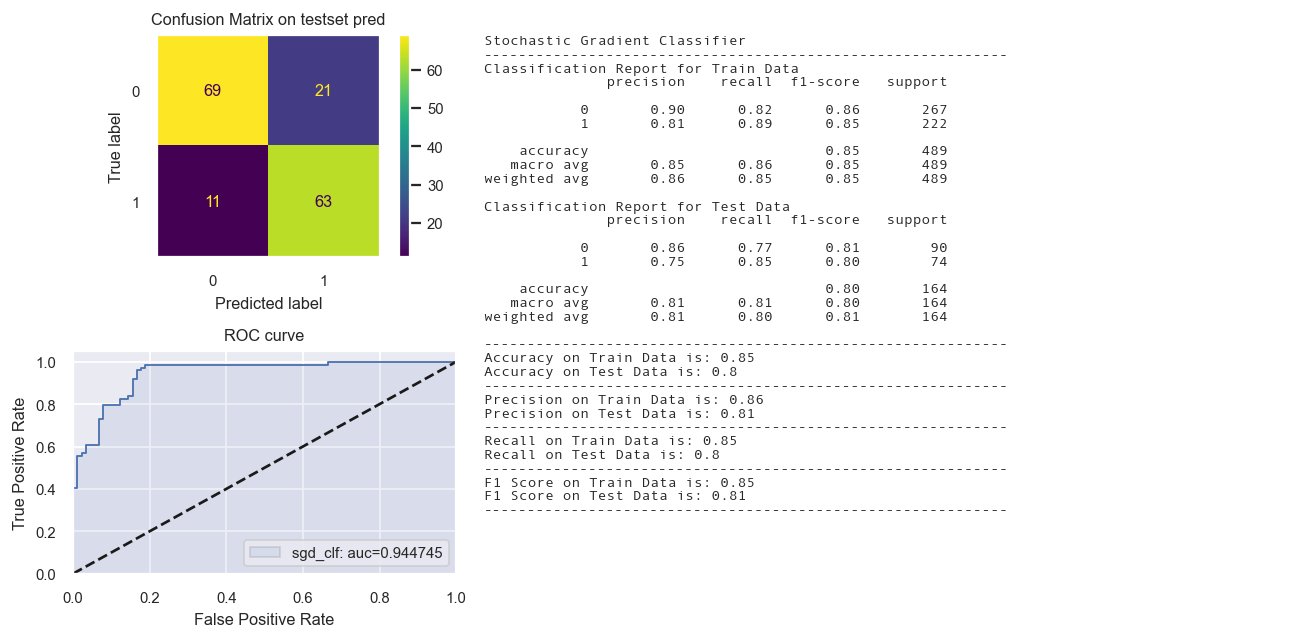
Logistic Regression Classifier
lr = LogisticRegression(max_iter = 1000,random_state = 48)
st_time = time.time()
lr.fit(X_train_tr1, y_train_tr)
yp_train_tr = lr.predict(X_train_tr1)
yp_test_tr = lr.predict(X_test_tr1)
en_time = time.time()
print('Total time: {:.2f}s'.format(en_time-st_time))
#print(evaluation_parametrics(y_train_tr,yp_train_tr,y_test_tr,yp_test_tr))
dict1 = create_dict(lr, "Logistic Regression Classifier", y_train_tr, yp_train_tr, y_test_tr, yp_test_tr)
dict_perf.update(dict1)
fig = Confusion_matrix_ROC_AUC('lr','Logistic Regression Classifier',lr, X_train_tr1, y_train_tr,X_test_tr1,y_test_tr)
Total time: 0.02s
Calibrated Classifier CV not needed.
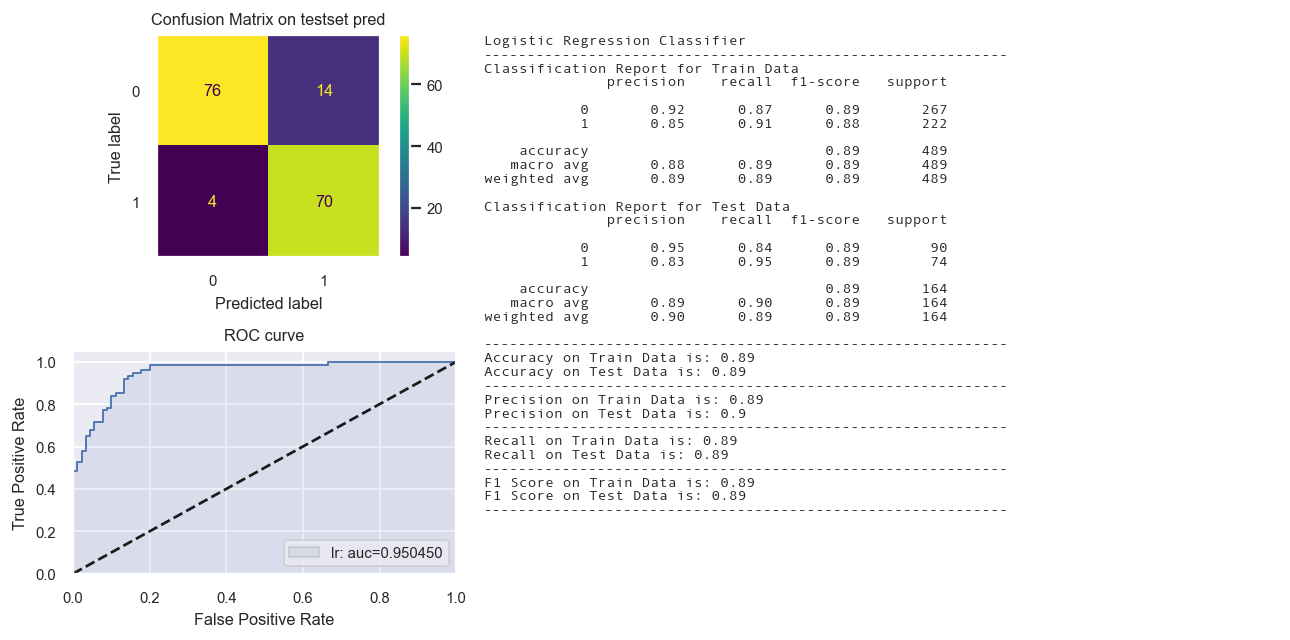
Random Forest Classifier
rf_clf = RandomForestClassifier(max_depth=5, random_state=42)
st_time = time.time()
rf_clf.fit(X_train_tr2, y_train_tr)
yp_train_tr = rf_clf.predict(X_train_tr2)
yp_test_tr = rf_clf.predict(X_test_tr2)
en_time = time.time()
print('Total time: {:.2f}s'.format(en_time-st_time))
#print(evaluation_parametrics(y_train_tr,yp_train_tr,y_test_tr,yp_test_tr))
dict1 = create_dict(rf_clf, "Random Forest Classifier",
y_train_tr, yp_train_tr, y_test_tr, yp_test_tr)
dict_perf.update(dict1)
fig = Confusion_matrix_ROC_AUC('rf_clf','Random Forest Classifier',rf_clf,
X_train_tr2, y_train_tr,X_test_tr2,y_test_tr)
Total time: 0.15s
Calibrated Classifier CV not needed.
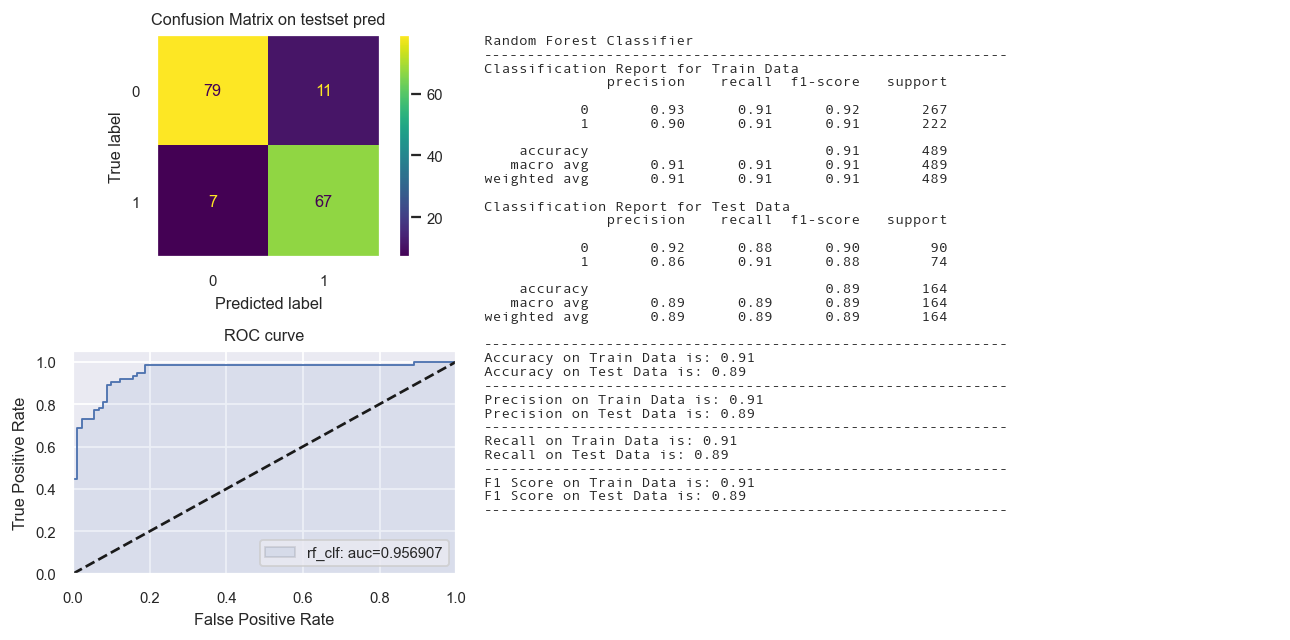
KNN Classifier
# training a KNN classifier
knn_clf = KNeighborsClassifier(n_neighbors = 7)
st_time = time.time()
knn_clf.fit(X_train_tr1, y_train_tr)
yp_train_tr = knn_clf.predict(X_train_tr1)
yp_test_tr = knn_clf.predict(X_test_tr1)
en_time = time.time()
print('Total time: {:.2f}s'.format(en_time-st_time))
#print(evaluation_parametrics(y_train_tr,yp_train_tr,y_test_tr,yp_test_tr))
dict1 = create_dict(knn_clf, "k-Nearest Neighbor Classifier", y_train_tr, yp_train_tr, y_test_tr, yp_test_tr)
dict_perf.update(dict1)
fig = Confusion_matrix_ROC_AUC('knn_clf', "k-Nearest Neighbor Classifier",knn_clf,
X_train_tr1, y_train_tr,X_test_tr1,y_test_tr)
Total time: 0.03s
Calibrated Classifier CV not needed.
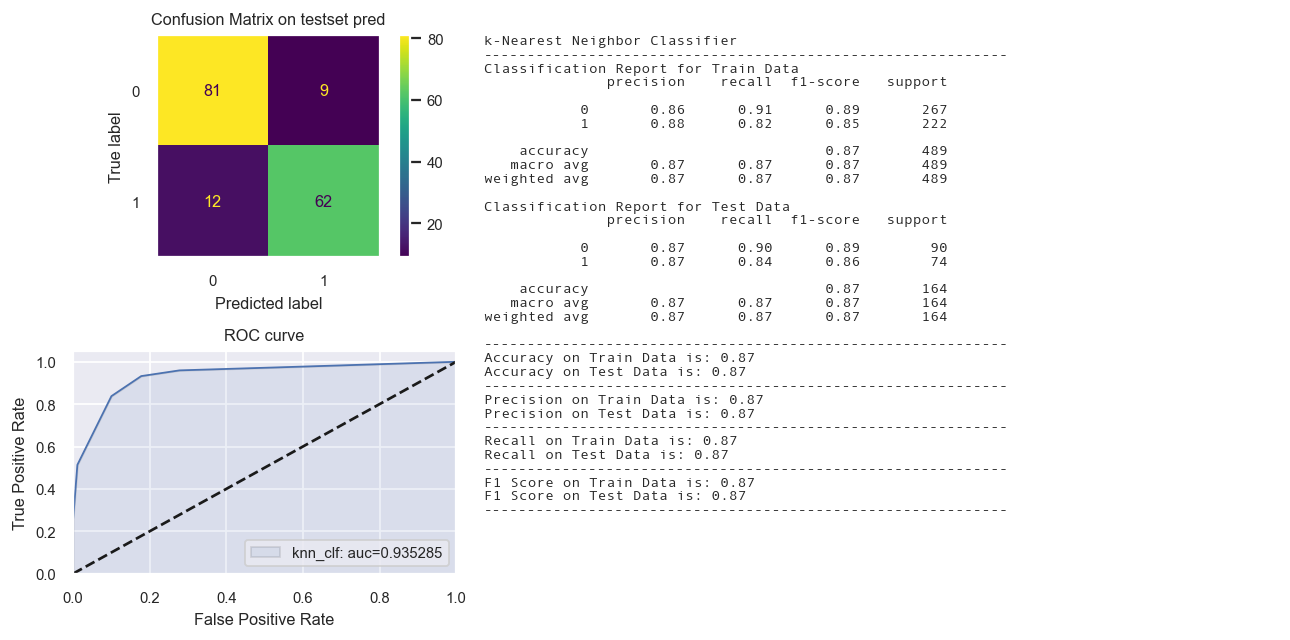
Naive Bayes Classifier
# training a Naive Bayes classifier
from sklearn.naive_bayes import GaussianNB
gnb_clf = GaussianNB()
st_time = time.time()
gnb_clf.fit(X_train_tr2, y_train_tr)
yp_train_tr = gnb_clf.predict(X_train_tr2)
yp_test_tr = gnb_clf.predict(X_test_tr2)
en_time = time.time()
print('Total time: {:.2f}s'.format(en_time-st_time))
#print(evaluation_parametrics(y_train_tr,yp_train_tr,y_test_tr,yp_test_tr))
dict1 = create_dict(gnb_clf, "Gaussian Naive Bayes Classifier", y_train_tr, yp_train_tr, y_test_tr, yp_test_tr)
dict_perf.update(dict1)
fig = Confusion_matrix_ROC_AUC('gnb_clf', "Gaussian Naive Bayes Classifier",gnb_clf,
X_train_tr2, y_train_tr,X_test_tr2,y_test_tr)
Total time: 0.00s
Calibrated Classifier CV not needed.
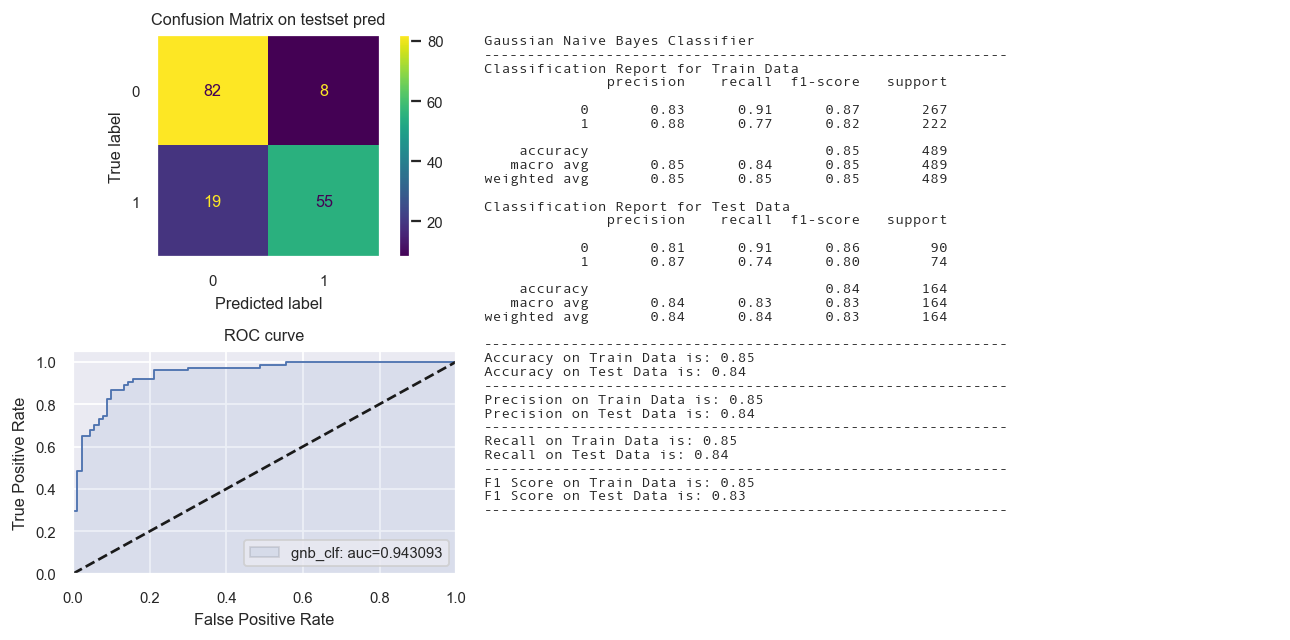
Linear Support Vector Classifier
svm = LinearSVC(class_weight='balanced', verbose=False, max_iter=10000, tol=1e-4, C=0.1)
st_time = time.time()
svm.fit(X_train_tr1,y_train_tr)
yp_train_tr = svm.predict(X_train_tr1)
yp_test_tr = svm.predict(X_test_tr1)
en_time = time.time()
print('Total time: {:.2f}s'.format(en_time-st_time))
#print(evaluation_parametrics(y_train_tr,yp_train_tr,y_test_tr,yp_test_tr))
dict1 = create_dict(svm, "Support Vector Classifier", y_train_tr, yp_train_tr, y_test_tr, yp_test_tr)
dict_perf.update(dict1)
fig = Confusion_matrix_ROC_AUC('LinearSVC', "Support Vector Classifier",svm,
X_train_tr1, y_train_tr,X_test_tr1,y_test_tr)
Total time: 0.01s
Calibrated Classifier CV needed.
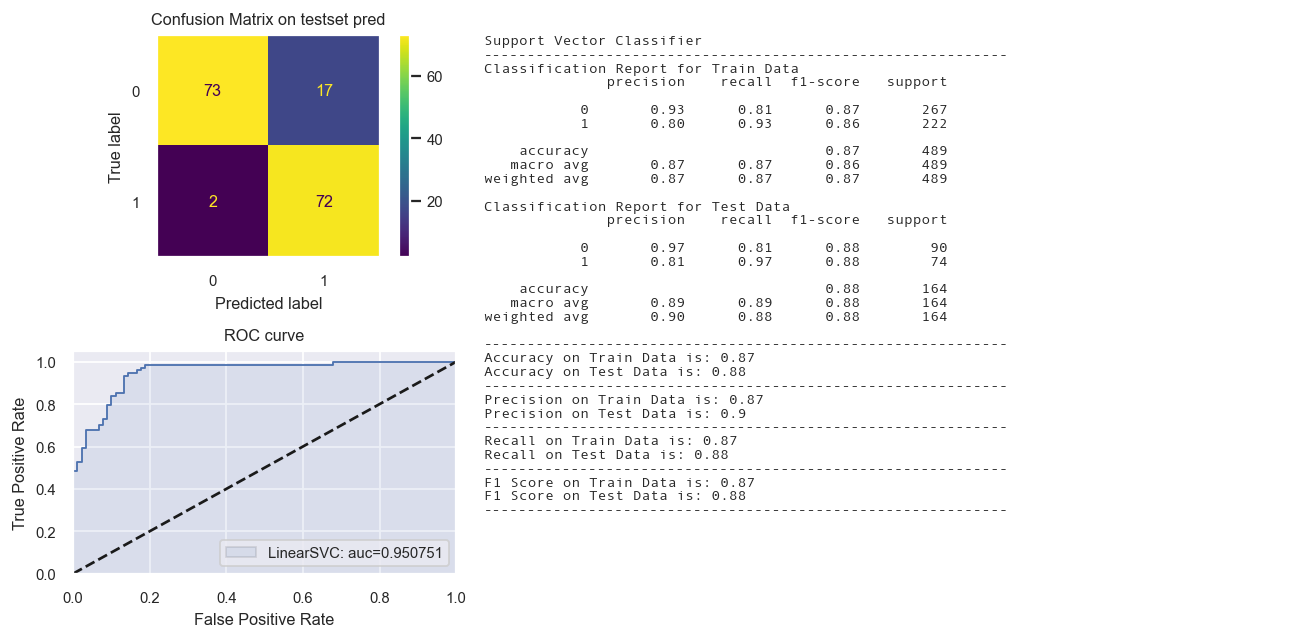
Decision Tree Classifier
dt = DecisionTreeClassifier(max_depth = 5,random_state = 48)
# Keeping max_depth = 7 to avoid overfitting
dt.fit(X_train_tr2,y_train_tr)
yp_train_tr = dt.predict(X_train_tr2)
yp_test_tr = dt.predict(X_test_tr2)
en_time = time.time()
print('Total time: {:.2f}s'.format(en_time-st_time))
#print(evaluation_parametrics(y_train_tr,yp_train_tr,y_test_tr,yp_test_tr))
dict1 = create_dict(dt, "Decision Tree Classifier", y_train_tr, yp_train_tr, y_test_tr, yp_test_tr)
dict_perf.update(dict1)
fig = Confusion_matrix_ROC_AUC('dt', "Decision Tree Classifier", dt,
X_train_tr2, y_train_tr,X_test_tr2,y_test_tr)
Total time: 0.53s
Calibrated Classifier CV not needed.
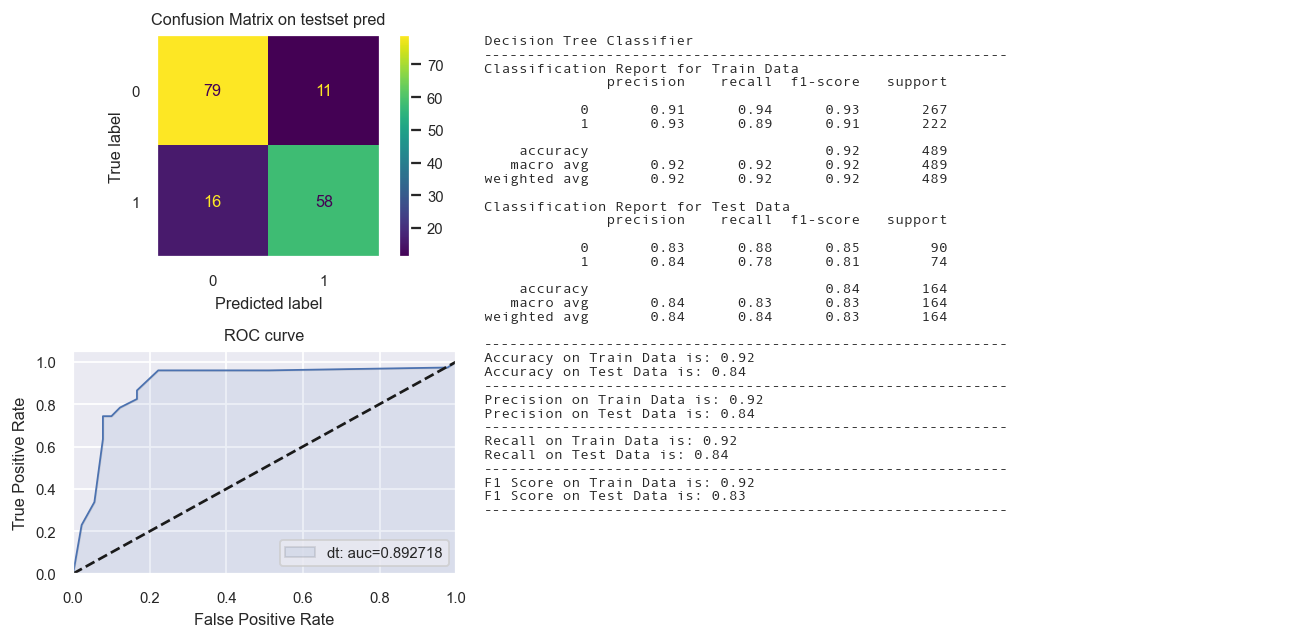
Gradient Boosting Model
gb_model = GradientBoostingClassifier(n_estimators=50, max_depth=5)
st_time = time.time()
gb_model.fit(X_train_tr2,y_train_tr)
yp_train_tr = gb_model.predict(X_train_tr2)
yp_test_tr = gb_model.predict(X_test_tr2)
en_time = time.time()
print('Total time: {:.2f}s'.format(en_time-st_time))
#print(evaluation_parametrics(y_train_tr,yp_train_tr,y_test_tr,yp_test_tr))
dict1 = create_dict(gb_model, "Gradient Boosting Classifier", y_train_tr, yp_train_tr, y_test_tr, yp_test_tr)
dict_perf.update(dict1)
fig = Confusion_matrix_ROC_AUC('gb_model', "Gradient Boosting Classifier", gb_model,
X_train_tr2, y_train_tr,X_test_tr2,y_test_tr)
Total time: 0.11s
Calibrated Classifier CV not needed.
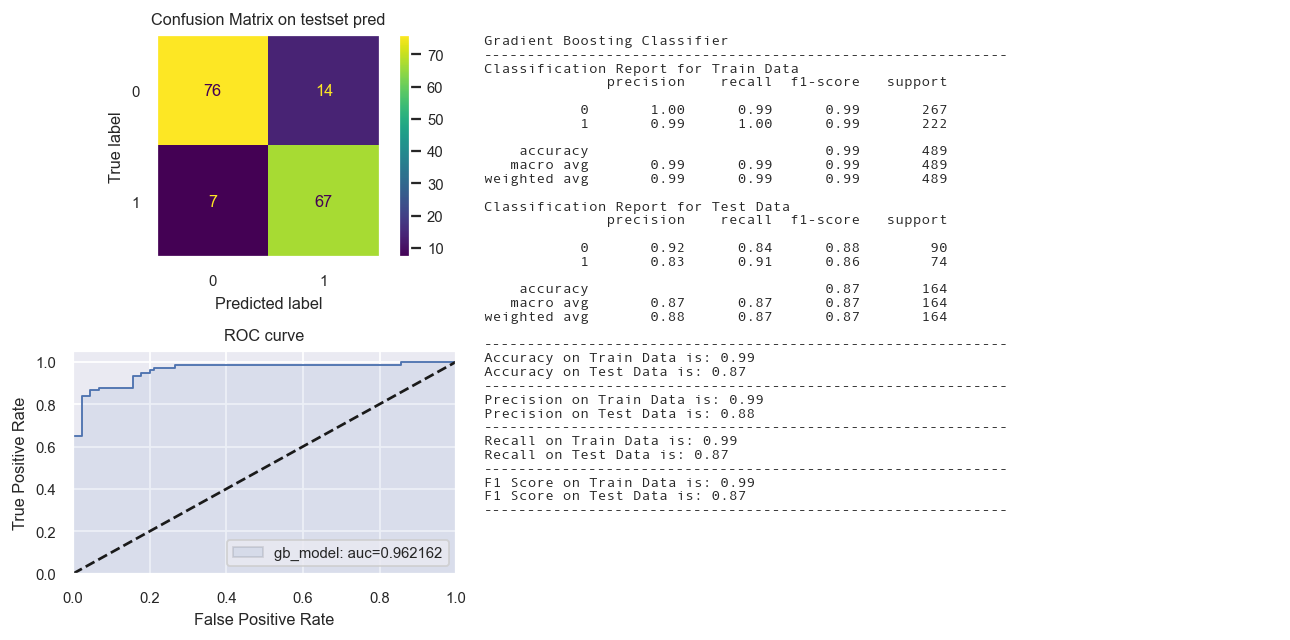
Linear Discriminant Analysis Model
lda_model = LinearDiscriminantAnalysis()
st_time = time.time()
lda_model.fit(X_train_tr1,y_train_tr)
yp_train_tr = lda_model.predict(X_train_tr1)
yp_test_tr = lda_model.predict(X_test_tr1)
en_time = time.time()
#print('Total time: {:.2f}s'.format(en_time-st_time))
evaluation_parametrics(y_train_tr,yp_train_tr,y_test_tr,yp_test_tr)
dict1 = create_dict(lda_model, "Linear Discriminant Analysis Classifier",
y_train_tr, yp_train_tr, y_test_tr, yp_test_tr)
dict_perf.update(dict1)
fig = Confusion_matrix_ROC_AUC('lda_model', "Linear Discriminant Analysis Classifier", lda_model,
X_train_tr1, y_train_tr,X_test_tr1,y_test_tr)
Calibrated Classifier CV not needed.
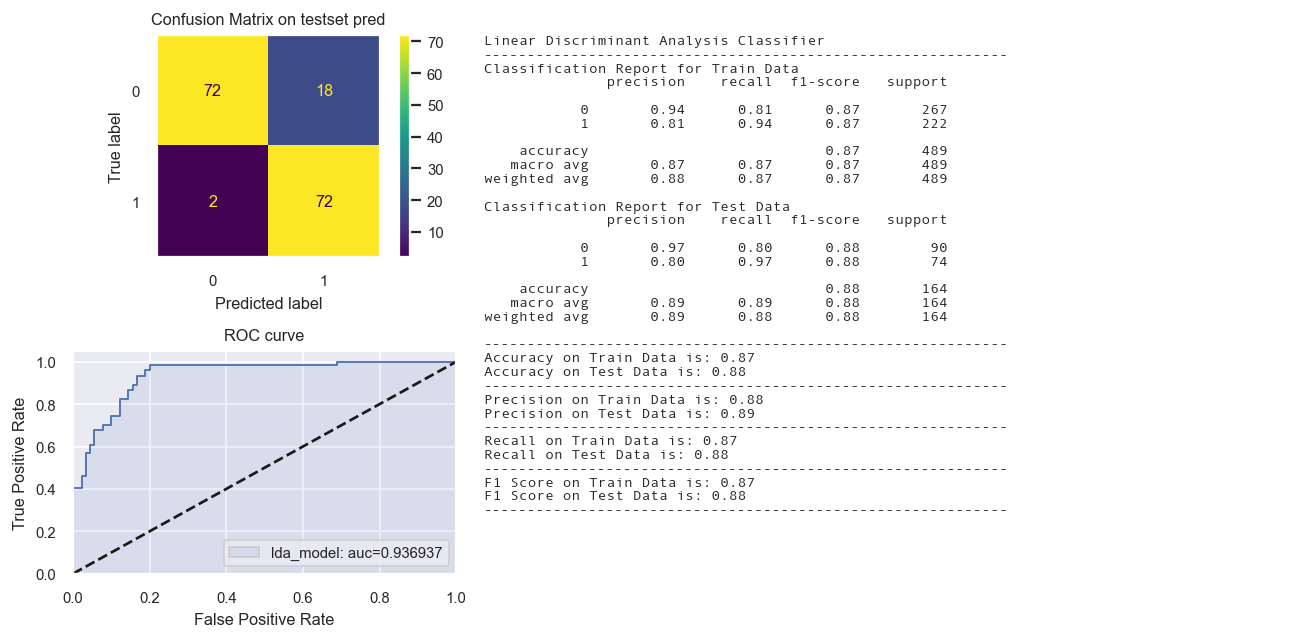
We also do a quick comparison of ROC curves with AUC scores as below.
from matplotlib import pyplot as plt
import sklearn
from sklearn.metrics import roc_curve, auc
#from sklearn.cross_validation import train_test_split
from sklearn.linear_model import LogisticRegression
from sklearn.tree import DecisionTreeClassifier
from sklearn.ensemble import RandomForestClassifier
from sklearn.naive_bayes import GaussianNB
# name -> (line format, classifier)
CLASS_MAP = {
'LogisticRegression':('-', LogisticRegression()),
'Naive Bayes': ('--', GaussianNB()),
'Decision Tree':('.-', DecisionTreeClassifier(max_depth=5)),
'Random Forest':(':', RandomForestClassifier( max_depth=5, n_estimators=10, max_features=1)),
}
# Divide cols by independent/dependent, rows by test/ train
#X, Y = df[df.columns[:3]], (df['species']=='virginica') X_train, X_test, Y_train, Y_test = \
#train_test_split(X, Y, test_size=.8)
#X_train_tr, y_train_tr,X_test_tr,y_test_tr
for name, (line_fmt, model) in CLASS_MAP.items():
model.fit(X_train_tr1, y_train_tr)
# array w one col per label
preds = model.predict_proba(X_test_tr1)
pred = pd.Series(preds[:,1])
fpr, tpr, thresholds = roc_curve(y_test_tr, pred)
auc_score = auc(fpr, tpr)
label='%s: auc=%f' % (name, auc_score)
plt.plot(fpr, tpr, line_fmt,
linewidth=1, label=label)
plt.legend(loc="lower right")
plt.title('Comparing Classifiers')
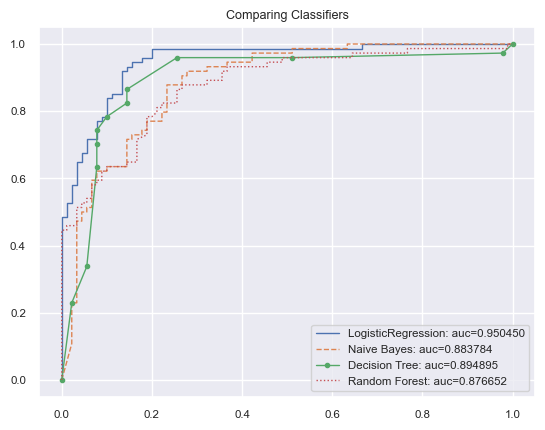
Listing the performance from all the models
display_results(dict_perf).style.background_gradient(cmap='Blues')
| Accuracy | F1 | Recall | Precision | |||||
|---|---|---|---|---|---|---|---|---|
| Train | Test | Train | Test | Train | Test | Train | Test | |
| SGD Classifier | 0.8528 | 0.8049 | 0.8531 | 0.8053 | 0.8528 | 0.8049 | 0.8568 | 0.8117 |
| Logistic Regression Classifier | 0.8855 | 0.8902 | 0.8857 | 0.8905 | 0.8855 | 0.8902 | 0.8878 | 0.8974 |
| Random Forest Classifier | 0.9141 | 0.8902 | 0.9142 | 0.8904 | 0.9141 | 0.8902 | 0.9144 | 0.8917 |
| k-Nearest Neighbor Classifier | 0.8712 | 0.8720 | 0.8707 | 0.8717 | 0.8712 | 0.8720 | 0.8719 | 0.8720 |
| Gaussian Naive Bayes Classifier | 0.8487 | 0.8354 | 0.8475 | 0.8335 | 0.8487 | 0.8354 | 0.8512 | 0.8395 |
| Support Vector Classifier | 0.8650 | 0.8841 | 0.8652 | 0.8842 | 0.8650 | 0.8841 | 0.8738 | 0.8992 |
| Decision Tree Classifier | 0.9182 | 0.8354 | 0.9181 | 0.8347 | 0.9182 | 0.8354 | 0.9184 | 0.8356 |
| Gradient Boosting Classifier | 0.9939 | 0.8780 | 0.9939 | 0.8783 | 0.9939 | 0.8780 | 0.9939 | 0.8795 |
| Linear Discriminant Analysis Classifier | 0.8691 | 0.8780 | 0.8693 | 0.8780 | 0.8691 | 0.8780 | 0.8789 | 0.8949 |
Model Validation using K-Fold CrossValidation
We will be iterating through the individual pipelines within the pipeline list specifically for k-fold cross-validation.
In each iteration :
- We will doing 10 fold stratified CV on Train data using cross_val_score and specifying the composite model/estimator. The scoring used in cross_val_score is ‘accuracy’.
- The scores will be extracted and stored in a dictionary. Once an entire loop of training and testing of each model within the pipeline list is completed, the dictionary will be converted into a dataframe and a plot to compare the results from the different classifier models.
# Test options and evaluation metric
num_folds = 10
seed = 7
scoring = 'accuracy'
# Creating ColumnTransformer for preprocessing the training data folds and testing data fold within the k-fold
# Note that training data folds will be fitted and transformed
# The test data folds will be transformed
from sklearn.compose import ColumnTransformer
from sklearn.preprocessing import OneHotEncoder
num_attribs = ['A2', 'A3','A8', 'A11', 'A14', 'A15']
cat_attribs = ["A1","A4", "A5", "A6", "A7", "A9", "A10", "A12", "A13"]
preprocessor1 = ColumnTransformer([
("num", num_pipeline, num_attribs),
("cat", OneHotEncoder(handle_unknown='ignore'), cat_attribs)])
preprocessor2 = ColumnTransformer([("cat", OneHotEncoder(handle_unknown='ignore'), cat_attribs)],
remainder = 'passthrough')
# Creating list of classifier models
models = [('SGD',SGDClassifier(random_state=42)),
('LR',LogisticRegression(max_iter = 1000,random_state = 48)),
('RF',RandomForestClassifier(max_depth=2, random_state=42)),
('KNN',KNeighborsClassifier(n_neighbors = 7)),
('NB',GaussianNB()),
('SVC',LinearSVC(class_weight='balanced', verbose=False, max_iter=10000, tol=1e-4, C=0.1)),
('CART',DecisionTreeClassifier(max_depth = 7,random_state = 48)),
('GBM',GradientBoostingClassifier(n_estimators=50, max_depth=10)),
('LDA',LinearDiscriminantAnalysis())
]
# Creating the pipeline of model and the preprocessor for feeding into the k-fold crossvalidation
pipelines_list = []
for i in models:
if i[0] not in ['RF','CART', 'GBM']:
pipelines_list.append(('Scaled'+str(i[0]), Pipeline([('Preprocessor1', preprocessor1),i])))
else:
pipelines_list.append((str(i[0]), Pipeline([('Preprocessor2', preprocessor2),i])))
# Checking the pipeline
pipelines_list
[('ScaledSGD',
Pipeline(steps=[('Preprocessor1',
ColumnTransformer(transformers=[('num',
Pipeline(steps=[('std_scaler',
StandardScaler())]),
['A2', 'A3', 'A8', 'A11',
'A14', 'A15']),
('cat',
OneHotEncoder(handle_unknown='ignore'),
['A1', 'A4', 'A5', 'A6', 'A7',
'A9', 'A10', 'A12',
'A13'])])),
('SGD', SGDClassifier(random_state=42))])),
('ScaledLR',
Pipeline(steps=[('Preprocessor1',
ColumnTransformer(transformers=[('num',
Pipeline(steps=[('std_scaler',
StandardScaler())]),
['A2', 'A3', 'A8', 'A11',
'A14', 'A15']),
('cat',
OneHotEncoder(handle_unknown='ignore'),
['A1', 'A4', 'A5', 'A6', 'A7',
'A9', 'A10', 'A12',
'A13'])])),
('LR', LogisticRegression(max_iter=1000, random_state=48))])),
('RF',
Pipeline(steps=[('Preprocessor2',
ColumnTransformer(remainder='passthrough',
transformers=[('cat',
OneHotEncoder(handle_unknown='ignore'),
['A1', 'A4', 'A5', 'A6', 'A7',
'A9', 'A10', 'A12',
'A13'])])),
('RF', RandomForestClassifier(max_depth=2, random_state=42))])),
('ScaledKNN',
Pipeline(steps=[('Preprocessor1',
ColumnTransformer(transformers=[('num',
Pipeline(steps=[('std_scaler',
StandardScaler())]),
['A2', 'A3', 'A8', 'A11',
'A14', 'A15']),
('cat',
OneHotEncoder(handle_unknown='ignore'),
['A1', 'A4', 'A5', 'A6', 'A7',
'A9', 'A10', 'A12',
'A13'])])),
('KNN', KNeighborsClassifier(n_neighbors=7))])),
('ScaledNB',
Pipeline(steps=[('Preprocessor1',
ColumnTransformer(transformers=[('num',
Pipeline(steps=[('std_scaler',
StandardScaler())]),
['A2', 'A3', 'A8', 'A11',
'A14', 'A15']),
('cat',
OneHotEncoder(handle_unknown='ignore'),
['A1', 'A4', 'A5', 'A6', 'A7',
'A9', 'A10', 'A12',
'A13'])])),
('NB', GaussianNB())])),
('ScaledSVC',
Pipeline(steps=[('Preprocessor1',
ColumnTransformer(transformers=[('num',
Pipeline(steps=[('std_scaler',
StandardScaler())]),
['A2', 'A3', 'A8', 'A11',
'A14', 'A15']),
('cat',
OneHotEncoder(handle_unknown='ignore'),
['A1', 'A4', 'A5', 'A6', 'A7',
'A9', 'A10', 'A12',
'A13'])])),
('SVC',
LinearSVC(C=0.1, class_weight='balanced', max_iter=10000,
verbose=False))])),
('CART',
Pipeline(steps=[('Preprocessor2',
ColumnTransformer(remainder='passthrough',
transformers=[('cat',
OneHotEncoder(handle_unknown='ignore'),
['A1', 'A4', 'A5', 'A6', 'A7',
'A9', 'A10', 'A12',
'A13'])])),
('CART', DecisionTreeClassifier(max_depth=7, random_state=48))])),
('GBM',
Pipeline(steps=[('Preprocessor2',
ColumnTransformer(remainder='passthrough',
transformers=[('cat',
OneHotEncoder(handle_unknown='ignore'),
['A1', 'A4', 'A5', 'A6', 'A7',
'A9', 'A10', 'A12',
'A13'])])),
('GBM',
GradientBoostingClassifier(max_depth=10, n_estimators=50))])),
('ScaledLDA',
Pipeline(steps=[('Preprocessor1',
ColumnTransformer(transformers=[('num',
Pipeline(steps=[('std_scaler',
StandardScaler())]),
['A2', 'A3', 'A8', 'A11',
'A14', 'A15']),
('cat',
OneHotEncoder(handle_unknown='ignore'),
['A1', 'A4', 'A5', 'A6', 'A7',
'A9', 'A10', 'A12',
'A13'])])),
('LDA', LinearDiscriminantAnalysis())]))]
# Evaluating the Algorithms
results = []
names = []
st_time = time.time()
for name, pipeline in pipelines_list:
kfold = KFold(n_splits=num_folds, random_state=seed, shuffle = True)
cv_results = cross_val_score(pipeline, X_train, y_train, cv=kfold, scoring=scoring)
print(type(pipeline))
results.append(cv_results)
names.append(name)
msg = "{:<10}: {:<6} ({:^6})".format(name, cv_results.mean().round(4), cv_results.std().round(4))
print(msg)
print(X_train)
en_time = time.time()
print('Total time: {:.4f}s'.format(en_time-st_time))
<class 'sklearn.pipeline.Pipeline'>
ScaledSGD : 0.8119 (0.0897)
A1 A2 A3 A4 A5 A6 A7 A8 A9 A10 A11 A12 A13 A14 A15
7 a 22.92 11.585 u g cc v 0.040 t f 0.0 f g 80.0 1349.0
64 b 26.67 4.250 u g cc v 4.290 t t 1.0 t g 120.0 0.0
320 b 21.25 1.500 u g w v 1.500 f f 0.0 f g 150.0 8.0
358 b 32.42 3.000 u g d v 0.165 f f 0.0 t g 120.0 0.0
628 b 29.25 13.000 u g d h 0.500 f f 0.0 f g 228.0 0.0
.. .. ... ... .. .. .. .. ... .. .. ... .. .. ... ...
621 b 22.67 0.165 u g c j 2.250 f f 0.0 t s 0.0 0.0
521 a 30.00 5.290 u g e dd 2.250 t t 5.0 t g 99.0 500.0
156 a 28.50 3.040 y p x h 2.540 t t 1.0 f g 70.0 0.0
509 b 21.00 4.790 y p w v 2.250 t t 1.0 t g 80.0 300.0
119 a 20.75 10.335 u g cc h 0.335 t t 1.0 t g 80.0 50.0
[489 rows x 15 columns]
<class 'sklearn.pipeline.Pipeline'>
ScaledLR : 0.8569 (0.0481)
A1 A2 A3 A4 A5 A6 A7 A8 A9 A10 A11 A12 A13 A14 A15
7 a 22.92 11.585 u g cc v 0.040 t f 0.0 f g 80.0 1349.0
64 b 26.67 4.250 u g cc v 4.290 t t 1.0 t g 120.0 0.0
320 b 21.25 1.500 u g w v 1.500 f f 0.0 f g 150.0 8.0
358 b 32.42 3.000 u g d v 0.165 f f 0.0 t g 120.0 0.0
628 b 29.25 13.000 u g d h 0.500 f f 0.0 f g 228.0 0.0
.. .. ... ... .. .. .. .. ... .. .. ... .. .. ... ...
621 b 22.67 0.165 u g c j 2.250 f f 0.0 t s 0.0 0.0
521 a 30.00 5.290 u g e dd 2.250 t t 5.0 t g 99.0 500.0
156 a 28.50 3.040 y p x h 2.540 t t 1.0 f g 70.0 0.0
509 b 21.00 4.790 y p w v 2.250 t t 1.0 t g 80.0 300.0
119 a 20.75 10.335 u g cc h 0.335 t t 1.0 t g 80.0 50.0
[489 rows x 15 columns]
<class 'sklearn.pipeline.Pipeline'>
RF : 0.8589 (0.0494)
A1 A2 A3 A4 A5 A6 A7 A8 A9 A10 A11 A12 A13 A14 A15
7 a 22.92 11.585 u g cc v 0.040 t f 0.0 f g 80.0 1349.0
64 b 26.67 4.250 u g cc v 4.290 t t 1.0 t g 120.0 0.0
320 b 21.25 1.500 u g w v 1.500 f f 0.0 f g 150.0 8.0
358 b 32.42 3.000 u g d v 0.165 f f 0.0 t g 120.0 0.0
628 b 29.25 13.000 u g d h 0.500 f f 0.0 f g 228.0 0.0
.. .. ... ... .. .. .. .. ... .. .. ... .. .. ... ...
621 b 22.67 0.165 u g c j 2.250 f f 0.0 t s 0.0 0.0
521 a 30.00 5.290 u g e dd 2.250 t t 5.0 t g 99.0 500.0
156 a 28.50 3.040 y p x h 2.540 t t 1.0 f g 70.0 0.0
509 b 21.00 4.790 y p w v 2.250 t t 1.0 t g 80.0 300.0
119 a 20.75 10.335 u g cc h 0.335 t t 1.0 t g 80.0 50.0
[489 rows x 15 columns]
<class 'sklearn.pipeline.Pipeline'>
ScaledKNN : 0.8406 (0.0622)
A1 A2 A3 A4 A5 A6 A7 A8 A9 A10 A11 A12 A13 A14 A15
7 a 22.92 11.585 u g cc v 0.040 t f 0.0 f g 80.0 1349.0
64 b 26.67 4.250 u g cc v 4.290 t t 1.0 t g 120.0 0.0
320 b 21.25 1.500 u g w v 1.500 f f 0.0 f g 150.0 8.0
358 b 32.42 3.000 u g d v 0.165 f f 0.0 t g 120.0 0.0
628 b 29.25 13.000 u g d h 0.500 f f 0.0 f g 228.0 0.0
.. .. ... ... .. .. .. .. ... .. .. ... .. .. ... ...
621 b 22.67 0.165 u g c j 2.250 f f 0.0 t s 0.0 0.0
521 a 30.00 5.290 u g e dd 2.250 t t 5.0 t g 99.0 500.0
156 a 28.50 3.040 y p x h 2.540 t t 1.0 f g 70.0 0.0
509 b 21.00 4.790 y p w v 2.250 t t 1.0 t g 80.0 300.0
119 a 20.75 10.335 u g cc h 0.335 t t 1.0 t g 80.0 50.0
[489 rows x 15 columns]
<class 'sklearn.pipeline.Pipeline'>
ScaledNB : 0.6685 (0.0645)
A1 A2 A3 A4 A5 A6 A7 A8 A9 A10 A11 A12 A13 A14 A15
7 a 22.92 11.585 u g cc v 0.040 t f 0.0 f g 80.0 1349.0
64 b 26.67 4.250 u g cc v 4.290 t t 1.0 t g 120.0 0.0
320 b 21.25 1.500 u g w v 1.500 f f 0.0 f g 150.0 8.0
358 b 32.42 3.000 u g d v 0.165 f f 0.0 t g 120.0 0.0
628 b 29.25 13.000 u g d h 0.500 f f 0.0 f g 228.0 0.0
.. .. ... ... .. .. .. .. ... .. .. ... .. .. ... ...
621 b 22.67 0.165 u g c j 2.250 f f 0.0 t s 0.0 0.0
521 a 30.00 5.290 u g e dd 2.250 t t 5.0 t g 99.0 500.0
156 a 28.50 3.040 y p x h 2.540 t t 1.0 f g 70.0 0.0
509 b 21.00 4.790 y p w v 2.250 t t 1.0 t g 80.0 300.0
119 a 20.75 10.335 u g cc h 0.335 t t 1.0 t g 80.0 50.0
[489 rows x 15 columns]
<class 'sklearn.pipeline.Pipeline'>
ScaledSVC : 0.8529 (0.0424)
A1 A2 A3 A4 A5 A6 A7 A8 A9 A10 A11 A12 A13 A14 A15
7 a 22.92 11.585 u g cc v 0.040 t f 0.0 f g 80.0 1349.0
64 b 26.67 4.250 u g cc v 4.290 t t 1.0 t g 120.0 0.0
320 b 21.25 1.500 u g w v 1.500 f f 0.0 f g 150.0 8.0
358 b 32.42 3.000 u g d v 0.165 f f 0.0 t g 120.0 0.0
628 b 29.25 13.000 u g d h 0.500 f f 0.0 f g 228.0 0.0
.. .. ... ... .. .. .. .. ... .. .. ... .. .. ... ...
621 b 22.67 0.165 u g c j 2.250 f f 0.0 t s 0.0 0.0
521 a 30.00 5.290 u g e dd 2.250 t t 5.0 t g 99.0 500.0
156 a 28.50 3.040 y p x h 2.540 t t 1.0 f g 70.0 0.0
509 b 21.00 4.790 y p w v 2.250 t t 1.0 t g 80.0 300.0
119 a 20.75 10.335 u g cc h 0.335 t t 1.0 t g 80.0 50.0
[489 rows x 15 columns]
<class 'sklearn.pipeline.Pipeline'>
CART : 0.8283 (0.0387)
A1 A2 A3 A4 A5 A6 A7 A8 A9 A10 A11 A12 A13 A14 A15
7 a 22.92 11.585 u g cc v 0.040 t f 0.0 f g 80.0 1349.0
64 b 26.67 4.250 u g cc v 4.290 t t 1.0 t g 120.0 0.0
320 b 21.25 1.500 u g w v 1.500 f f 0.0 f g 150.0 8.0
358 b 32.42 3.000 u g d v 0.165 f f 0.0 t g 120.0 0.0
628 b 29.25 13.000 u g d h 0.500 f f 0.0 f g 228.0 0.0
.. .. ... ... .. .. .. .. ... .. .. ... .. .. ... ...
621 b 22.67 0.165 u g c j 2.250 f f 0.0 t s 0.0 0.0
521 a 30.00 5.290 u g e dd 2.250 t t 5.0 t g 99.0 500.0
156 a 28.50 3.040 y p x h 2.540 t t 1.0 f g 70.0 0.0
509 b 21.00 4.790 y p w v 2.250 t t 1.0 t g 80.0 300.0
119 a 20.75 10.335 u g cc h 0.335 t t 1.0 t g 80.0 50.0
[489 rows x 15 columns]
<class 'sklearn.pipeline.Pipeline'>
GBM : 0.8017 (0.0538)
A1 A2 A3 A4 A5 A6 A7 A8 A9 A10 A11 A12 A13 A14 A15
7 a 22.92 11.585 u g cc v 0.040 t f 0.0 f g 80.0 1349.0
64 b 26.67 4.250 u g cc v 4.290 t t 1.0 t g 120.0 0.0
320 b 21.25 1.500 u g w v 1.500 f f 0.0 f g 150.0 8.0
358 b 32.42 3.000 u g d v 0.165 f f 0.0 t g 120.0 0.0
628 b 29.25 13.000 u g d h 0.500 f f 0.0 f g 228.0 0.0
.. .. ... ... .. .. .. .. ... .. .. ... .. .. ... ...
621 b 22.67 0.165 u g c j 2.250 f f 0.0 t s 0.0 0.0
521 a 30.00 5.290 u g e dd 2.250 t t 5.0 t g 99.0 500.0
156 a 28.50 3.040 y p x h 2.540 t t 1.0 f g 70.0 0.0
509 b 21.00 4.790 y p w v 2.250 t t 1.0 t g 80.0 300.0
119 a 20.75 10.335 u g cc h 0.335 t t 1.0 t g 80.0 50.0
[489 rows x 15 columns]
<class 'sklearn.pipeline.Pipeline'>
ScaledLDA : 0.8529 (0.0433)
A1 A2 A3 A4 A5 A6 A7 A8 A9 A10 A11 A12 A13 A14 A15
7 a 22.92 11.585 u g cc v 0.040 t f 0.0 f g 80.0 1349.0
64 b 26.67 4.250 u g cc v 4.290 t t 1.0 t g 120.0 0.0
320 b 21.25 1.500 u g w v 1.500 f f 0.0 f g 150.0 8.0
358 b 32.42 3.000 u g d v 0.165 f f 0.0 t g 120.0 0.0
628 b 29.25 13.000 u g d h 0.500 f f 0.0 f g 228.0 0.0
.. .. ... ... .. .. .. .. ... .. .. ... .. .. ... ...
621 b 22.67 0.165 u g c j 2.250 f f 0.0 t s 0.0 0.0
521 a 30.00 5.290 u g e dd 2.250 t t 5.0 t g 99.0 500.0
156 a 28.50 3.040 y p x h 2.540 t t 1.0 f g 70.0 0.0
509 b 21.00 4.790 y p w v 2.250 t t 1.0 t g 80.0 300.0
119 a 20.75 10.335 u g cc h 0.335 t t 1.0 t g 80.0 50.0
[489 rows x 15 columns]
Total time: 4.1834s
tmp = pd.DataFrame(results).transpose()
tmp.columns = names
tmp
| ScaledSGD | ScaledLR | RF | ScaledKNN | ScaledNB | ScaledSVC | CART | GBM | ScaledLDA | |
|---|---|---|---|---|---|---|---|---|---|
| 0 | 0.8571 | 0.9184 | 0.9388 | 0.9184 | 0.6735 | 0.9184 | 0.7959 | 0.8980 | 0.9184 |
| 1 | 0.6735 | 0.8367 | 0.7755 | 0.7143 | 0.6122 | 0.7959 | 0.8163 | 0.7959 | 0.8163 |
| 2 | 0.8367 | 0.7959 | 0.8163 | 0.8163 | 0.7347 | 0.8163 | 0.7347 | 0.6939 | 0.8367 |
| 3 | 0.8980 | 0.8980 | 0.9184 | 0.9184 | 0.6327 | 0.8776 | 0.8367 | 0.8163 | 0.8776 |
| 4 | 0.9184 | 0.8776 | 0.8980 | 0.8367 | 0.7959 | 0.8571 | 0.8571 | 0.7755 | 0.8571 |
| 5 | 0.8776 | 0.8367 | 0.8163 | 0.8367 | 0.7143 | 0.8367 | 0.8571 | 0.8367 | 0.8163 |
| 6 | 0.6327 | 0.7959 | 0.8163 | 0.7959 | 0.6122 | 0.8367 | 0.8776 | 0.8163 | 0.8367 |
| 7 | 0.7755 | 0.9184 | 0.8776 | 0.8571 | 0.6735 | 0.8776 | 0.8163 | 0.8163 | 0.8776 |
| 8 | 0.7959 | 0.7959 | 0.8571 | 0.7959 | 0.6735 | 0.7959 | 0.8367 | 0.7347 | 0.7755 |
| 9 | 0.8542 | 0.8958 | 0.8750 | 0.9167 | 0.5625 | 0.9167 | 0.8542 | 0.8333 | 0.9167 |
tmp.mean()
ScaledSGD 0.8119
ScaledLR 0.8569
RF 0.8589
ScaledKNN 0.8406
ScaledNB 0.6685
ScaledSVC 0.8529
CART 0.8283
GBM 0.8017
ScaledLDA 0.8529
dtype: float64
print('The top 4 algorithms based on cross-validation performance are :')
for alg, value in tmp.mean().sort_values(ascending = False)[0:4].iteritems():
print('{: <20} : {: 1.4f}'.format(alg, value))
The top 4 algorithms based on crossvalidation performance are :
RF : 0.8589
ScaledLR : 0.8569
ScaledSVC : 0.8529
ScaledLDA : 0.8529
Comparing the mean and standard deviation of performance measures
# from cross validation using various classifier models
tmp1 = pd.concat([tmp.mean(), tmp.std()], axis = 1, keys = ['mean','std_dev'])
tmp1.style.background_gradient(cmap = 'Blues')
| mean | std_dev | |
|---|---|---|
| ScaledSGD | 0.8119 | 0.0945 |
| ScaledLR | 0.8569 | 0.0507 |
| RF | 0.8589 | 0.0521 |
| ScaledKNN | 0.8406 | 0.0656 |
| ScaledNB | 0.6685 | 0.0680 |
| ScaledSVC | 0.8529 | 0.0446 |
| CART | 0.8283 | 0.0408 |
| GBM | 0.8017 | 0.0567 |
| ScaledLDA | 0.8529 | 0.0457 |
tmp1['mean'].idxmax(axis = 'columns')
'RF'
np.argsort(tmp1['mean'])
ScaledSGD 4
ScaledLR 7
RF 0
ScaledKNN 6
ScaledNB 3
ScaledSVC 8
CART 5
GBM 1
ScaledLDA 2
Name: mean, dtype: int64
# Understanding of np.argsort or df['col'].argsort()
n = 2
algorithm_index = tmp1['mean'].index.to_list()
top_n_idx = tmp1['mean'].argsort()[::-1][:n].values
top2_algorithms = [algorithm_index[i] for i in top_n_idx]
top2_algorithms
['RF', 'ScaledLR']
top_n_idx
array([2, 1])
n = 2
tmp1['mean'].argsort()[::-1][n]
5
n = 2
avgDists = np.array([1, 8, 6, 9, 4])
ids = avgDists.argsort()
ids
array([0, 4, 2, 1, 3])
type(tmp1['mean'].argsort()[0])
numpy.int64
# Compare Algorithms
plt.rcdefaults()
fig = plt.figure(figsize = (6,3))
ax = fig.add_subplot(111)
sns.boxplot(data = tmp, color = 'lightgrey', linewidth = 1, width = 0.5, orient = 'h')
# Coloring box-plots of top 2 mean values
n = 2
algorithm_index = tmp1['mean'].index.to_list()
top_2_idx = tmp1['mean'].argsort()[::-1][:n].values
for i in top_2_idx :
# Select which box you want to change
mybox = ax.patches[i]
# Change the appearance of that box
mybox.set_facecolor('salmon')
mybox.set_alpha(0.8)
# mybox.set_edgecolor('black')
# mybox.set_linewidth(3)
# Coloring box-plots of 3rd and 4th mean values
top_3_4_idx = tmp1['mean'].argsort()[::-1][2:4].values
for i in top_3_4_idx :
# Select which box you want to change
mybox = ax.patches[i]
# Change the appearance of that box
mybox.set_facecolor('mediumturquoise')
mybox.set_alpha(0.7)
# mybox.set_edgecolor('black')
# mybox.set_linewidth(3)
ax.grid(True, alpha = 0.4, ls = '--')
ax.set_axisbelow(True)
[labels.set(rotation = 20, ha = 'right') for labels in ax.get_xticklabels()]
[labels.set(size = 8) for labels in ax.get_yticklabels()]
for key, _ in ax.spines._dict.items():
ax.spines._dict[key].set_linewidth(.5)
ax.set_title('Algorithm Comparison using 10-fold CV scores', ha = 'center' )
ax.set_xlabel('CV score')
#ax.set_ylim(0.6,1)
plt.show()
fig.savefig(path+'spotchecking algorithms using 10 fold CV.png', dpi = 175)
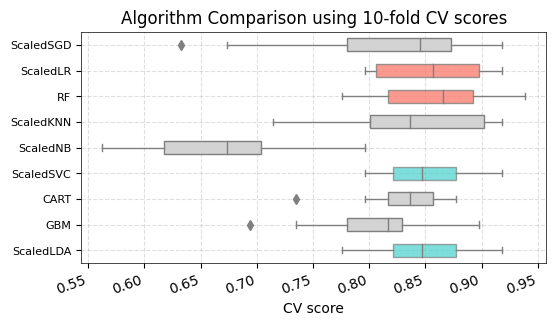
Results from simple Train Test split
display_results(dict_perf).style.background_gradient(cmap='Blues')
| Accuracy | F1 | Recall | Precision | |||||
|---|---|---|---|---|---|---|---|---|
| Train | Test | Train | Test | Train | Test | Train | Test | |
| SGD Classifier | 0.8528 | 0.8049 | 0.8531 | 0.8053 | 0.8528 | 0.8049 | 0.8568 | 0.8117 |
| Logistic Regression Classifier | 0.8855 | 0.8902 | 0.8857 | 0.8905 | 0.8855 | 0.8902 | 0.8878 | 0.8974 |
| Random Forest Classifier | 0.9141 | 0.8902 | 0.9142 | 0.8904 | 0.9141 | 0.8902 | 0.9144 | 0.8917 |
| k-Nearest Neighbor Classifier | 0.8712 | 0.8720 | 0.8707 | 0.8717 | 0.8712 | 0.8720 | 0.8719 | 0.8720 |
| Gaussian Naive Bayes Classifier | 0.8487 | 0.8354 | 0.8475 | 0.8335 | 0.8487 | 0.8354 | 0.8512 | 0.8395 |
| Support Vector Classifier | 0.8650 | 0.8841 | 0.8652 | 0.8842 | 0.8650 | 0.8841 | 0.8738 | 0.8992 |
| Decision Tree Classifier | 0.9182 | 0.8354 | 0.9181 | 0.8347 | 0.9182 | 0.8354 | 0.9184 | 0.8356 |
| Gradient Boosting Classifier | 0.9939 | 0.8780 | 0.9939 | 0.8783 | 0.9939 | 0.8780 | 0.9939 | 0.8795 |
| Linear Discriminant Analysis Classifier | 0.8691 | 0.8780 | 0.8693 | 0.8780 | 0.8691 | 0.8780 | 0.8789 | 0.8949 |
Selecting the Algorithms from train-test split and K-Fold CV
From both simple train/test/split and cross validation methods, we have shortlisted the below two classifiers with the highest accuracy measures :
– Logistic Regression Classifier and
– Random Forest Classifier
Tuning the Selected Algorithm
We will use GridsearchCV from scikitlearn to tune the shortlisted algorithms and find the best hyperparameter combinations for each. We will evaluate the tuned models and choose one for final deployment.
Tuning Logistic Regression Classifier
A grid search is performed for the Logistic Regression Classifier by varying the solver, and regularization strength controlled by C in sklearn. Check this useful link.
Also, the solvers do not support all the penalties. Check sklearn link
# https://stackoverflow.com/questions/62331674/sklearn-combine-gridsearchcv-with-column-transform-and-pipeline?noredirect=1&lq=1
from sklearn.preprocessing import StandardScaler, OneHotEncoder
from sklearn.compose import make_column_transformer
from sklearn.compose import make_column_selector
import pandas as pd # doctest: +SKIP
# define dataset
X, y = X_train, y_train
from sklearn.compose import make_column_selector
from sklearn.pipeline import make_pipeline, Pipeline
from sklearn.model_selection import GridSearchCV
from sklearn.impute import KNNImputer
from sklearn.linear_model import LinearRegression
from sklearn.model_selection import cross_val_score, KFold, RepeatedStratifiedKFold
from sklearn.impute import SimpleImputer
from sklearn.preprocessing import OneHotEncoder
#numerical_features=make_column_selector(dtype_include=np.number)
#cat_features=make_column_selector(dtype_exclude=np.number)
num_attribs = ['A2', 'A3','A8', 'A11', 'A14', 'A15']
cat_attribs = ["A1","A4", "A5", "A6", "A7", "A9", "A10", "A12", "A13"]
# Setting the pipeline for preprocessing numeric and categorical variables
preprocessor = ColumnTransformer([
("num", num_pipeline, num_attribs),
("cat", OneHotEncoder(handle_unknown='ignore'), cat_attribs)])
# Creating a composite estimator by appending classifier estimator to preprocessor pipeline
model_lr = make_pipeline(preprocessor,
LogisticRegression(random_state = 48, max_iter = 1000) )
# define models and parameters
#model = LogisticRegression()
solvers = ['newton-cg', 'lbfgs', 'liblinear']
penalty = ['l2']
c_values = [100, 10, 1.0, 0.1, 0.01]
# define grid search
grid_lr = dict(logisticregression__solver=solvers,
logisticregression__penalty=penalty,
logisticregression__C=c_values)
cv = RepeatedStratifiedKFold(n_splits=10, n_repeats=3, random_state=1)
# Instantiating GridSearchCV object with composite estimator, parameter grid, CV(crossvalidation generator)
grid_search_lr = GridSearchCV(estimator=model_lr, param_grid=grid_lr,
n_jobs=-1, cv=cv, scoring='accuracy',error_score=0)
grid_result_lr = grid_search_lr.fit(X, y)
# summarize results
print("Best: %f using %s" % (grid_result_lr.best_score_, grid_result_lr.best_params_))
means = grid_result_lr.cv_results_['mean_test_score']
stds = grid_result_lr.cv_results_['std_test_score']
params = grid_result_lr.cv_results_['params']
for mean, stdev, param in zip(means, stds, params):
print("%f (%f) with: %r" % (mean, stdev, param))
Best: 0.860913 using {'logisticregression__C': 0.1, 'logisticregression__penalty': 'l2', 'logisticregression__solver': 'liblinear'}
0.847917 (0.054990) with: {'logisticregression__C': 100, 'logisticregression__penalty': 'l2', 'logisticregression__solver': 'newton-cg'}
0.847917 (0.054990) with: {'logisticregression__C': 100, 'logisticregression__penalty': 'l2', 'logisticregression__solver': 'lbfgs'}
0.847917 (0.054990) with: {'logisticregression__C': 100, 'logisticregression__penalty': 'l2', 'logisticregression__solver': 'liblinear'}
0.853387 (0.049407) with: {'logisticregression__C': 10, 'logisticregression__penalty': 'l2', 'logisticregression__solver': 'newton-cg'}
0.854082 (0.049850) with: {'logisticregression__C': 10, 'logisticregression__penalty': 'l2', 'logisticregression__solver': 'lbfgs'}
0.853387 (0.049407) with: {'logisticregression__C': 10, 'logisticregression__penalty': 'l2', 'logisticregression__solver': 'liblinear'}
0.852693 (0.046922) with: {'logisticregression__C': 1.0, 'logisticregression__penalty': 'l2', 'logisticregression__solver': 'newton-cg'}
0.852693 (0.046922) with: {'logisticregression__C': 1.0, 'logisticregression__penalty': 'l2', 'logisticregression__solver': 'lbfgs'}
0.852693 (0.046922) with: {'logisticregression__C': 1.0, 'logisticregression__penalty': 'l2', 'logisticregression__solver': 'liblinear'}
0.858844 (0.047125) with: {'logisticregression__C': 0.1, 'logisticregression__penalty': 'l2', 'logisticregression__solver': 'newton-cg'}
0.858844 (0.047125) with: {'logisticregression__C': 0.1, 'logisticregression__penalty': 'l2', 'logisticregression__solver': 'lbfgs'}
0.860913 (0.047333) with: {'logisticregression__C': 0.1, 'logisticregression__penalty': 'l2', 'logisticregression__solver': 'liblinear'}
0.837032 (0.054992) with: {'logisticregression__C': 0.01, 'logisticregression__penalty': 'l2', 'logisticregression__solver': 'newton-cg'}
0.837032 (0.054992) with: {'logisticregression__C': 0.01, 'logisticregression__penalty': 'l2', 'logisticregression__solver': 'lbfgs'}
0.840434 (0.051608) with: {'logisticregression__C': 0.01, 'logisticregression__penalty': 'l2', 'logisticregression__solver': 'liblinear'}
set_config(display='text')
grid_result_lr.best_estimator_
Pipeline(steps=[('columntransformer',
ColumnTransformer(transformers=[('num',
Pipeline(steps=[('std_scaler',
StandardScaler())]),
['A2', 'A3', 'A8', 'A11',
'A14', 'A15']),
('cat',
OneHotEncoder(handle_unknown='ignore'),
['A1', 'A4', 'A5', 'A6', 'A7',
'A9', 'A10', 'A12',
'A13'])])),
('logisticregression',
LogisticRegression(C=0.1, max_iter=1000, random_state=48,
solver='liblinear'))])
Tuning RandomForest Classifier
A grid search is performed for the random forest model by varying the number of estimators and maximum number of features. These are the main parameters to adjust for ensemble methods. Check sklearn link.
# https://stackoverflow.com/questions/62331674/sklearn-combine-gridsearchcv-with-column-transform-and-pipeline?noredirect=1&lq=1
from sklearn.preprocessing import StandardScaler, OneHotEncoder
from sklearn.compose import make_column_transformer
from sklearn.compose import make_column_selector
import pandas as pd # doctest: +SKIP
# define dataset
X, y = X_train, y_train
from sklearn.compose import make_column_selector
from sklearn.pipeline import make_pipeline, Pipeline
from sklearn.model_selection import GridSearchCV
from sklearn.impute import KNNImputer
from sklearn.linear_model import LinearRegression
from sklearn.model_selection import cross_val_score, KFold
from sklearn.impute import SimpleImputer
from sklearn.preprocessing import OneHotEncoder
#numerical_features=make_column_selector(dtype_include=np.number)
#cat_features=make_column_selector(dtype_exclude=np.number)
num_attribs = ['A2', 'A3','A8', 'A11', 'A14', 'A15']
cat_attribs = ["A1","A4", "A5", "A6", "A7", "A9", "A10", "A12", "A13"]
preprocessor = ColumnTransformer([
("num", num_pipeline, num_attribs),
("cat", OneHotEncoder(handle_unknown='ignore'), cat_attribs)])
model_rf = make_pipeline(preprocessor, RandomForestClassifier())
# define model parameters
n_estimators = [10, 100, 1000]
max_features = ['sqrt', 'log2']
# define grid search
grid_rf = dict(randomforestclassifier__n_estimators=n_estimators,
randomforestclassifier__max_features=max_features
)
cv = RepeatedStratifiedKFold(n_splits=10, n_repeats=3, random_state=1)
grid_search_rf = GridSearchCV(estimator=model_rf, param_grid=grid_rf, n_jobs=-1, cv=cv, scoring='accuracy',error_score=0)
grid_result_rf = grid_search_rf.fit(X, y)
# summarize results
print("Best: %f using %s" % (grid_result_rf.best_score_, grid_result_rf.best_params_))
Best: 0.872562 using {'randomforestclassifier__max_features': 'sqrt', 'randomforestclassifier__n_estimators': 100}
means = grid_result_rf.cv_results_['mean_test_score']
stds = grid_result_rf.cv_results_['std_test_score']
params = grid_result_rf.cv_results_['params']
for mean, stdev, param in zip(means, stds, params):
print("%f (%f) with: %r" % (mean, stdev, param))
0.858149 (0.058613) with: {'randomforestclassifier__max_features': 'sqrt', 'randomforestclassifier__n_estimators': 10}
0.872562 (0.044866) with: {'randomforestclassifier__max_features': 'sqrt', 'randomforestclassifier__n_estimators': 100}
0.871840 (0.045962) with: {'randomforestclassifier__max_features': 'sqrt', 'randomforestclassifier__n_estimators': 1000}
0.850680 (0.045532) with: {'randomforestclassifier__max_features': 'log2', 'randomforestclassifier__n_estimators': 10}
0.869813 (0.046994) with: {'randomforestclassifier__max_features': 'log2', 'randomforestclassifier__n_estimators': 100}
0.871173 (0.043511) with: {'randomforestclassifier__max_features': 'log2', 'randomforestclassifier__n_estimators': 1000}
Training the final Model on full training set
The CV performance of the tuned models for both logistic regression and random forest classifier are close. We are choosing to go ahead with Logistic regression classifier as it is a simpler model and there is not a significant upside if we use the random forest classifier instead.
Since, refit = True in grid_search_lr (The GridSearchCV for logistic Regression), the best estimator - grid_result_lr.best_estimator_ is the final model that is trained on the entire model.
We will use the trained model to make predictions and assess performance on both training and test sets.
# Inspecting the hyperparameters of the tuned estimator
set_config(display='text')
grid_result_lr.best_estimator_
Pipeline(steps=[('columntransformer',
ColumnTransformer(transformers=[('num',
Pipeline(steps=[('std_scaler',
StandardScaler())]),
['A2', 'A3', 'A8', 'A11',
'A14', 'A15']),
('cat',
OneHotEncoder(handle_unknown='ignore'),
['A1', 'A4', 'A5', 'A6', 'A7',
'A9', 'A10', 'A12',
'A13'])])),
('logisticregression',
LogisticRegression(C=0.1, max_iter=1000, random_state=48,
solver='liblinear'))])
final_estimator = grid_result_lr.best_estimator_.named_steps['logisticregression']
print(final_estimator)
print('\n')
print('Coefficients of Logistic Regression Model : \n {}'.format(final_estimator.coef_))
LogisticRegression(C=0.1, max_iter=1000, random_state=48, solver='liblinear')
Coefficients of Logistic Regression Model :
[[-6.58541123e-03 -3.51822076e-03 3.09711492e-01 4.70027755e-01
-1.13323153e-01 4.35822579e-01 1.68285927e-02 -8.75341871e-02
7.47808800e-02 7.28776727e-02 -2.18364147e-01 7.28776727e-02
7.47808800e-02 -2.18364147e-01 -1.39144167e-01 4.01314072e-02
4.11012844e-01 8.55332882e-03 -2.12058549e-02 -3.27693790e-01
-1.76320240e-01 -2.68447620e-02 -2.30368098e-01 -2.52030447e-02
4.08624678e-02 5.64167500e-03 -3.60899378e-02 4.05962577e-01
6.25902716e-02 3.63074013e-02 -2.61934006e-01 1.02733304e-01
5.97703732e-02 8.88998116e-02 8.68297921e-04 -7.75378510e-02
-8.24031970e-02 -1.21443647e+00 1.14373088e+00 -3.02496249e-01
2.31790655e-01 1.00373967e-02 -8.07429912e-02 -1.80524180e-02
-1.20565649e-02 -4.05966115e-02]]
Testing the model on entire train set
final_model = grid_result_lr.best_estimator_
X_train_prepared = final_model['columntransformer'].transform(X_train)
train_predictions = final_model.named_steps['logisticregression'].predict(X_train_prepared)
print(classification_report(y_train,train_predictions))
#evaluation_parametrics(y_train,train_predictions,y_test,final_predictions)
cm = confusion_matrix(y_train,train_predictions, labels= final_model['logisticregression'].classes_)
disp = ConfusionMatrixDisplay(confusion_matrix=cm,
display_labels= final_model['logisticregression'].classes_)
sns.set(font_scale=1.5) # Adjust to fit
disp.plot()
plt.gca().grid(False)
plt.show()
precision recall f1-score support
0 0.91 0.85 0.88 267
1 0.83 0.91 0.87 222
accuracy 0.87 489
macro avg 0.87 0.88 0.87 489
weighted avg 0.88 0.87 0.87 489
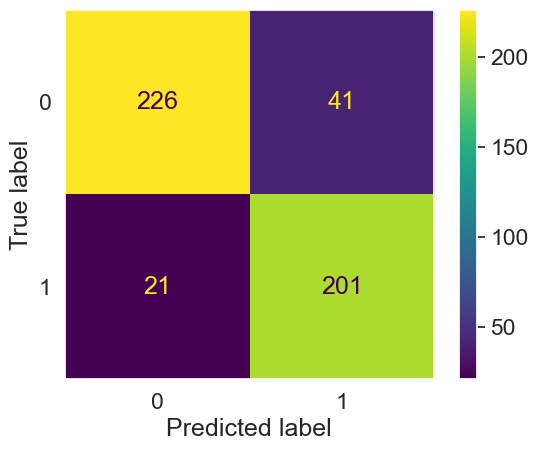
Testing the final model on test set
# Testing the final model on test set
X_test, y_test = X_test, y_test
X_test_prepared = final_model['columntransformer'].transform(X_test)
final_predictions = final_model['logisticregression'].predict(X_test_prepared)
print(classification_report(y_test, final_predictions))
cm = confusion_matrix(y_test,final_predictions, labels= final_model['logisticregression'].classes_)
disp = ConfusionMatrixDisplay(confusion_matrix=cm,
display_labels= final_model['logisticregression'].classes_)
sns.set(font_scale=1.5) # Adjust to fit
disp.plot()
plt.gca().grid(False)
plt.show()
precision recall f1-score support
0 0.94 0.84 0.89 90
1 0.83 0.93 0.88 74
accuracy 0.88 164
macro avg 0.88 0.89 0.88 164
weighted avg 0.89 0.88 0.88 164
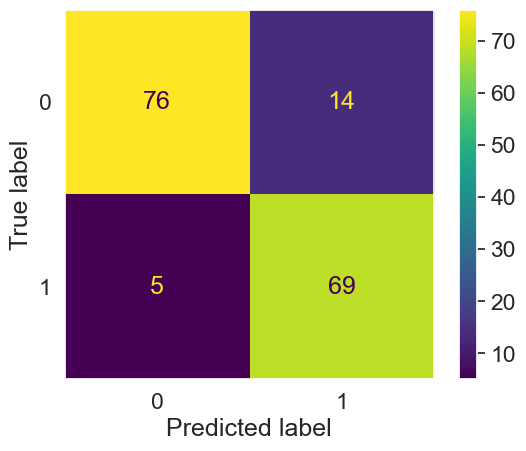
# Inspecting the pipeline objects
final_model.steps
[('columntransformer',
ColumnTransformer(transformers=[('num',
Pipeline(steps=[('std_scaler',
StandardScaler())]),
['A2', 'A3', 'A8', 'A11', 'A14', 'A15']),
('cat', OneHotEncoder(handle_unknown='ignore'),
['A1', 'A4', 'A5', 'A6', 'A7', 'A9', 'A10',
'A12', 'A13'])])),
('logisticregression',
LogisticRegression(C=0.1, max_iter=1000, random_state=48, solver='liblinear'))]
final_model['columntransformer'].named_transformers_['num'].get_params()
#https://stackoverflow.com/questions/67374844/how-to-find-out-standardscaling-parameters-mean-and-scale-when-using-column
{'memory': None,
'steps': [('std_scaler', StandardScaler())],
'verbose': False,
'std_scaler': StandardScaler(),
'std_scaler__copy': True,
'std_scaler__with_mean': True,
'std_scaler__with_std': True}
final_model['columntransformer'].named_transformers_['num'].named_steps['std_scaler'].__getstate__()
{'with_mean': True,
'with_std': True,
'copy': True,
'feature_names_in_': array(['A2', 'A3', 'A8', 'A11', 'A14', 'A15'], dtype=object),
'n_features_in_': 6,
'n_samples_seen_': 489,
'mean_': array([ 31.64194274, 4.80782209, 2.16182004, 2.62167689,
176.64212679, 1061.93251534]),
'var_': array([1.44527358e+02, 2.44550009e+01, 1.08188797e+01, 2.72208798e+01,
2.82397022e+04, 3.48843393e+07]),
'scale_': array([1.20219532e+01, 4.94519979e+00, 3.28920655e+00, 5.21736330e+00,
1.68046726e+02, 5.90629658e+03]),
'_sklearn_version': '1.0.2'}
Save model for later use
Using pickle operations, trained model is saved in the serialized format to a file. Later, this serialized file can be loaded to deserialize the model for its usage.
import joblib
joblib.dump(final_model, 'credit-screening-lr.pkl')
['credit-screening-lr.pkl']
clf = joblib.load('credit-screening-lr.pkl')
clf
Pipeline(steps=[('columntransformer',
ColumnTransformer(transformers=[('num',
Pipeline(steps=[('std_scaler',
StandardScaler())]),
['A2', 'A3', 'A8', 'A11',
'A14', 'A15']),
('cat',
OneHotEncoder(handle_unknown='ignore'),
['A1', 'A4', 'A5', 'A6', 'A7',
'A9', 'A10', 'A12',
'A13'])])),
('logisticregression',
LogisticRegression(C=0.1, max_iter=1000, random_state=48,
solver='liblinear'))])
print(list(dir(clf.named_steps['logisticregression'])))
['C', '__class__', '__delattr__', '__dict__', '__dir__', '__doc__', '__eq__', '__format__', '__ge__', '__getattribute__', '__getstate__', '__gt__', '__hash__', '__init__', '__init_subclass__', '__le__', '__lt__', '__module__', '__ne__', '__new__', '__reduce__', '__reduce_ex__', '__repr__', '__setattr__', '__setstate__', '__sizeof__', '__str__', '__subclasshook__', '__weakref__', '_check_feature_names', '_check_n_features', '_estimator_type', '_get_param_names', '_get_tags', '_more_tags', '_predict_proba_lr', '_repr_html_', '_repr_html_inner', '_repr_mimebundle_', '_validate_data', 'class_weight', 'classes_', 'coef_', 'decision_function', 'densify', 'dual', 'fit', 'fit_intercept', 'get_params', 'intercept_', 'intercept_scaling', 'l1_ratio', 'max_iter', 'multi_class', 'n_features_in_', 'n_iter_', 'n_jobs', 'penalty', 'predict', 'predict_log_proba', 'predict_proba', 'random_state', 'score', 'set_params', 'solver', 'sparsify', 'tol', 'verbose', 'warm_start']
clf.named_steps['logisticregression'].coef_
array([[-6.58541123e-03, -3.51822076e-03, 3.09711492e-01,
4.70027755e-01, -1.13323153e-01, 4.35822579e-01,
1.68285927e-02, -8.75341871e-02, 7.47808800e-02,
7.28776727e-02, -2.18364147e-01, 7.28776727e-02,
7.47808800e-02, -2.18364147e-01, -1.39144167e-01,
4.01314072e-02, 4.11012844e-01, 8.55332882e-03,
-2.12058549e-02, -3.27693790e-01, -1.76320240e-01,
-2.68447620e-02, -2.30368098e-01, -2.52030447e-02,
4.08624678e-02, 5.64167500e-03, -3.60899378e-02,
4.05962577e-01, 6.25902716e-02, 3.63074013e-02,
-2.61934006e-01, 1.02733304e-01, 5.97703732e-02,
8.88998116e-02, 8.68297921e-04, -7.75378510e-02,
-8.24031970e-02, -1.21443647e+00, 1.14373088e+00,
-3.02496249e-01, 2.31790655e-01, 1.00373967e-02,
-8.07429912e-02, -1.80524180e-02, -1.20565649e-02,
-4.05966115e-02]])
Useful Resources
- Data Mining for Business Analytics - Concepts, Techniques, and Applications in Python by Galit Shmueli, Nitin R. Patel, and Peter C. Bruce, Chapter 09
- Machine Learning and Data Science Blueprints for Finance by Brad Lookabaugh, Hariom Tatsat, and Sahil Puri
